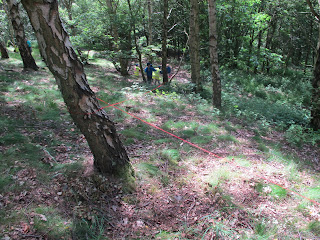Thanks to Amanda for sharing this idea which is a lovely way to nurture a deeper connection between children and the woodland.
I started the session by telling the children that there in the woodlands was their very own tree. I told them there was a way to find out which was their tree and to do this they first had to find three lines on the palm of one of their hands. Using a pen they then drew over the three lines they've found. Then they were told that to find their tree they could match the three lines on their hands with lines that they found in the trees. When they'd found a match, they'd found their tree. Interestingly, some children were drawn to the same tree, so I congratulated them on finding one of the 'sharing trees'.
They went on to look closely and explore their tree, to get to know it better. The children were free to use their forest artist books when and if they wanted to. Many children chose to capture wonderful written and drawn descriptions of their tree.
In the following weeks children returned to their trees time again to sit and relax or to play. Their tree had become their special place.





























